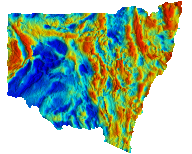Isostatic Bouger
Type of resources
Topics
Keywords
Contact for the resource
Provided by
Years
status
-

Pseudocolour image of Bouguer gravity with a histogram-equalised colour stretch. Cooler colours indicate lower Bouguer gravity values and warmer colours represent higher values. The intensity layer is the Bouguer gravity greyscale image enhanced by a 3x3 sun filter with the sun illumination set at 45 degrees elevation and 90 degrees azimuth. Bouguer gravity compensates for variations in latitude, 'free-air' elevation and Bouguer correction (assuming a crustal density of 2.67 T/m³). Attention: Please ensure your version of the NSW gravity merges contains the date ‘2024-10-30’ in their filename. An update was made to remedy location errors in the initial release. Apologies for any inconvenience.
-

Pseudocolour image of isostatic residual gravity with a histogram-equalised colour-stretch. Cooler colours indicate lower gravity values and warmer colours represent higher values. The image has been enhanced with a 3×3 sun filter with the sun illumination set at 45 degrees elevation and 90 degrees azimuth. Bouguer gravity compensates for variations in latitude, 'free-air' elevation and Bouguer correction (assuming a crustal density of 2.67 T/m³). The isostatic correction removes the effect of the thickness of Earth’s crust due to changes in topography. Attention: Please ensure your version of the NSW gravity merges contains the date ‘2024-10-30’ in their filename. An update was made to remedy location errors in the initial release. Apologies for any inconvenience.
-
This is a preliminary low-resolution, pseudocolour image of airborne acquired Bouguer gravity with a histogram-equalised colour stretch. Cooler colours indicate lower Bouguer gravity values and warmer colours represent higher values. Bouguer gravity compensates for variations in latitude, 'free-air' elevation and Bouguer correction (assuming a crustal density of 2.67 T/m³). This image shows airborne gravity data from a survey that is ongoing. The Department of Customer Service has contracted two experienced specialist companies to fly the airborne survey. Final data will be available in 2024 at a higher resolution. Preliminary data should not be used in geological interpretations.
-
Isostatic residual Bouguer gravity image overlain on tilt-filtered total magnetic intensity reduced to the pole (Tilt TMI RTP) image. The image is a partially-transparent pseudocolour layer of Isostatic residual Bouguer gravity, with a histogram-equalised colour-stretch, overlain on a greyscale intensity layer of the Tilt TMI RTP, with a histogram-equalised stretch. Bouguer gravity compensates for variations in latitude, 'free-air' elevation and Bouguer correction (assuming a crustal density of 2.67 T/m³). The isostatic correction removes the effect of variations in the thickness of the Earth’s crust due to changes in topography. The tilt-angle filter of total magnetic intensity produces a local positive maximum over a magnetic source and is zero near the edge of the source, and is useful for tracing geological structure below variable depths of cover.
-

Greyscale image of first vertical derivative (1VD) of isostatic residual gravity (Iso-grav). The 1VD filter shows the rate of change in the isostatic gravity data. Darker tones indicate lower values and lighter tones represent higher values. Attention: Please ensure your version of the NSW gravity merges contains the date ‘2024-10-30’ in their filename. An update was made to remedy location errors in the initial release. Apologies for any inconvenience.
-

Greyscale image of first vertical derivative (1VD) of Bouguer gravity. Darker tones indicate lower values and lighter tones represent higher values. Bouguer gravity compensates for variations in latitude, 'free-air' elevation and Bouguer correction (assuming a crustal density of 2.67 T/m³). Attention: Please ensure your version of the NSW gravity merges contains the date ‘2024-10-30’ in their filename. An update was made to remedy location errors in the initial release. Apologies for any inconvenience.
-
Pseudocolour image of isostatic residual Bouguer gravity with a histogram-equalised colour stretch. Cooler colours indicate lower Bouguer gravity values and warmer colours represent higher values. The intensity layer is the Bouguer gravity greyscale image enhanced by a 3x3 sun filter with the sun illumination set at 45 degrees elevation and 90 degrees azimuth. Bouguer gravity compensates for variations in latitude, 'free-air' elevation and Bouguer correction (assuming a crustal density of 2.67 T/m³). The isostatic correction removes the effect of variations in the thickness of the Earth’s crust due to changes in topography. The isostatic effect is particularly strong under the Great Dividing Range.
-

The semi-transparent Bouguer gravity image is displayed using cooler colours (blue) to indicate lower gravity values and warmer colours (red) represent higher values. The underlying greyscale tilt-angle filtered total magnetic intensity image has been reduced to the pole (Tilt TMI RTP). The tilt-angle filter of the total magnetic intensity produces a local positive maximum (white) over a magnetic source and is zero near the edge of the source (grey), and is useful for tracing geological structure below variable depths of cover. Both image layers were generated using a histogram-equalised colour-stretch. Attention: Please ensure your version of the NSW gravity merges contains the date ‘2024-10-30’ in their filename. An update was made to remedy location errors in the initial release. Apologies for any inconvenience.
-

The semi-transparent isostatic residual gravity image is displayed using cooler colours (blue) to indicate lower gravity values and warmer colours (red) represent higher values. The underlying greyscale tilt-angle filtered total magnetic intensity image that has been reduced to the pole (Tilt TMI RTP). The tilt-angle filter of the total magnetic intensity produces a local positive maximum (white) over a magnetic source and is zero near the edge of the source (grey), and is useful for tracing geological structure below variable depths of cover. Both image layers were generated using a histogram-equalised colour-stretch. Attention: Please ensure your version of the NSW gravity merges contains the date ‘2024-10-30’ in their filename. An update was made to remedy location errors in the initial release. Apologies for any inconvenience.
 NSW Geoscience Metadata
NSW Geoscience Metadata